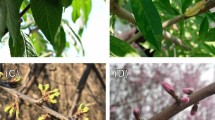Abstract
Impatiens necrotic spot virus (INSV) was first detected in New Zealand in August 2003 in Freesia refracta plants growing in a nursery on the South Island of New Zealand. Surveys were conducted to determine the extent of spread of the virus within the nursery and to other sites around the country. INSV was confirmed by a newly developed reverse transcription-polymerase chain reaction (RT-PCR) in impatiens (Impatiens walleriana), primula (Primula obconica) and Ranunculus sp. at the original site and in impatiens (I. walleriana) at two additional North Island sites. Infected material was destroyed and a management program established with the industry. However, in June 2006 a begonia (Begonia × tuberhybrida) specimen from a fourth North Island nursery was received which was found to be infected with INSV. Other species confirmed by RT-PCR to be infected at this site include cyclamen (Cyclamen persicum), gardenia (Gardenia jasminoides), gerbera (Gerbera jamesonii), as well as hibiscus (Hibiscus rosa-sinensis), which is a new host for INSV. Partial nucleotide sequences obtained by RT-PCR were found to be closely related to published sequences.
Similar content being viewed by others
References
Abad J, New S, Speck J, Ochoa-Corona F, Moyer J (2005) Phylogenetics of Impatiens necrotic spot virus (INSV) based on optimal sequence alignment (OSA) of the N, NsM and L protein genes. Phytopathology 95, S1.
Adkins S, Rosskopf EN (2002) Key West nightshade, a new experimental host for plant viruses. Plant Disease 86, 1310–1314. doi: 10.1094/ PDIS.2002.86.12.1310
Allan Herbarium (2000) Nga Tipu o Aotearoa — New Zealand Plant Names Database. Landcare Research, New Zealand. Available at http://www. nzflora.landcareresearch.co.nz/ [Verified 20 May 2009]
Allex D, Winoq M-L, Cailly M, Feinberg M, Hostachy B (2003) Mise en œuvre d’un test interlaboratoire des tospovirus (TSWV et INSV). I. Validation d’un mode opératoire officiel. Phytoma 560, 6–10.
Bucher E, Sijen T, de Haan P, Goldbach R, Prins M (2003) Negative-strand tospoviruses and tenuiviruses carry a gene for a suppressor of gene silencing at analogous genomic positions. Journal of Virology 77, 1329–1336. doi: 10.1128/JVI.77.2.1329-1336.2003
Campbell LR, Robb KL, Ullman DE (2008) The complete tospovirus host list. Available at http://www.oznet.ksu.edu/tospovirus/ [Verified 20 May 2009]
Chamberlain EE, Taylor GG (1936) The occurrence of spotted wilt on tomatoes in New Zealand. New Zealand Journal of Agriculture 52, 9–17.
Daughtrey ML, Jones RK, Moyer JW, Daub ME, Baker JR (1997) Tospoviruses strike the greenhouse industry: INSV has become a major pathogen of the greenhouse industry. Plant Disease 81, 1220–1230. doi: 10.1094/PDIS.1997.81.11.1220
de Haan P, de Avila AC, Kormelink R, Westerbroek A, Gielen JJL, Peters D, Goldbach R (1992) The nucleotide sequence of the S RNA of Impatiens necrotic spot virus, a novel tospovirus. FEBS Letters 306, 27–32. doi: 10.1016/0014-5793(92)80830-A
Guindon S, Gascuel O (2003) A simple, fast and accurate algorithm to estimate large phylogenies by maximum likelihood. Systematic Biology 52, 696–704. doi: 10.1080/10635150390235520
Hausbeck MK, Welliver RA, Derr MA, Gildow FE (1992) Tomato spotted wilt survey among greenhouse ornamentals in Pennsylvania. Plant Disease 76, 795–800.
Kerr JP, Hewett EW, Aitken AG (2004) ‘New Zealand Horticulture facts and figures: fruit, flowers and vegetables.’ (HortResearch — The Horticulture and Food Research Institute of New Zealand Ltd: Auckland)
Law MD, Moyer JW (1990) A tomato spotted wilt-like virus with a serologically distinct N protein. The Journal of General Virology 71, 933–938. doi: 10.1099/0022-1317-71-4-933
Law MD, Speck J, Moyer JW (1992) The MRNA of Impatiens necrotic spot tospovirus (Bunyaviridae) has an ambisense genomic organisation. Virology 188, 732–741. doi: 10.1016/0042-6822(92)90528-W
Lebas BSM, Ochoa-Corona FM, Elliott DR, Tang Z, Alexander BJR, Froud KJ (2004) An investigation of an outbreak of Impatiens necrotic spot virus in New Zealand. Phytopathology 94, S57.
McNeill MR, Phillips CB, Bell NL, Proffitt JR (2006) Potential spread of pests in New Zealand through commercial transport of nursery plants. New Zealand Plant Protection 59, 75–79.
Milne RG, Franki RIB (1984) Should tomato spotted wilt be considered as a possible member of the family Bunyaviridae? Intervirology 22, 72–76. doi: 10.1159/000149536
Mohamed NA, Randles JW, Franki RIB (1973) Protein composition of tomato spotted wilt virus. Virology 56, 12–21. doi: 10.1016/0042-6822(73)90283-3
Nichol ST, Beaty BJ, Elliott RM, Goldbach R, Plyusnin A, Schmaljohn CS (2005) Bunyaviridae. In ‘The eighth report of the International Committee on Taxonomy of Viruses’. (Eds CM Fauquet, MA Mayo, J Maniloff, U Desselberger, LA Ball) pp. 695–716. (Springer: New York)
Roggero P, Dellavalle G, Ciuffo M, Pennazio S (1999) Effects of temperature on infection in Capsicum sp. and Nicotiana benthamiana by impatiens necrotic spot. European Journal of Plant Pathology 105, 509–512. doi: 10.1023/A:1008742516820
Rozen S, Skaletsky S (2000) Primer3 on the World Wide Web for general users and for biologist programmers. In ‘Bioinformatics methods and protocols: methods in molecular biology’. (Eds S Krawertz, S Misener) pp. 365–386. (Humana Press: Totowa, NJ)
Soellick T-R, Uhrig JF, Bucher GL, Kellmann J-W, Schreier PH (2000) The movement protein NSm of tomato spotted wilt tospovirus (TSWV): RNA binding, interaction with the TSWV N protein, and identification of interacting plant proteins. Proceedings of the National Academy of Sciences of the United States of America 97, 2373–2378. doi: 10.1073/pnas.030548397
Teulon DAJ, Neilson MC (2005) Distribution of western (glasshouse strain) and Intonsa flower thrips in New Zealand. New Zealand Plant Protection 58, 208–212.
Van Poelwijk F, Prins M, Goldbach R (1997) Completion of the Impatiens necrotic spot virus genome sequence and genetic comparison of the L protein within the family Bunyaviridae. The Journal of General Virology 78, 543–546.
Vicchi V, Fini P, Cardoni M (1999) Presence of Impatiens necrotic spot tospovirus (INSV) on vegetable crops in Emilia-Romagna region. Informatore Fitopatologico 49, 53–55.
Zuker M (2003) Mfold web server for nucleic acid folding and hybridisation prediction. Nucleic Acids Research 31, 3406–3415. doi: 10.1093/nar/ gkg595
Author information
Authors and Affiliations
Corresponding author
Rights and permissions
About this article
Cite this article
Elliott, D.R., Lebas, B.S.M., Ochoa-Corona, F.M. et al. Investigation of Impatiens necrotic spot virus outbreaks in New Zealand. Australasian Plant Pathology 38, 490–495 (2009). https://doi.org/10.1071/AP09031
Received:
Accepted:
Issue Date:
DOI: https://doi.org/10.1071/AP09031




